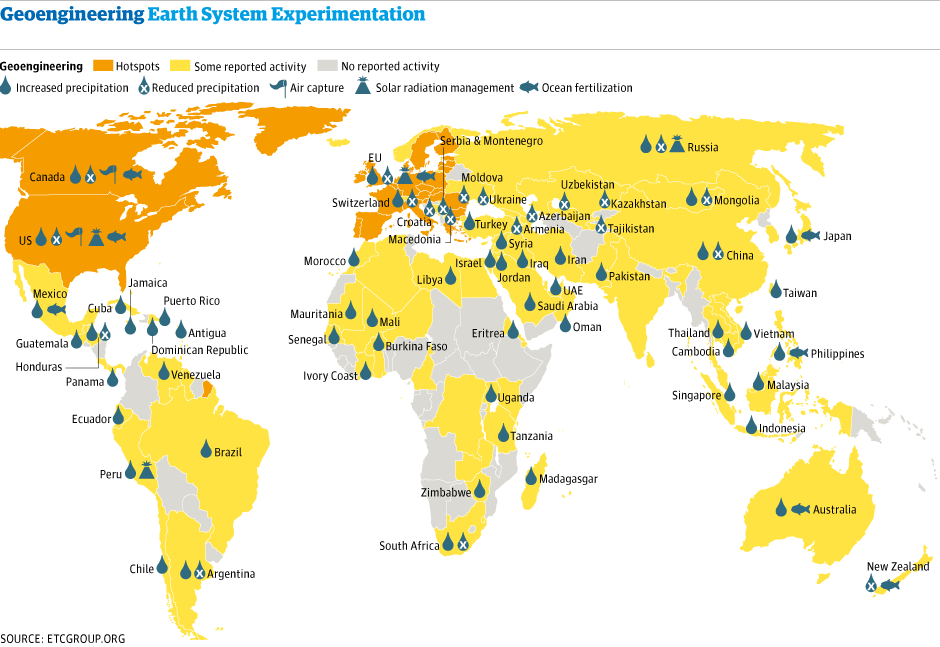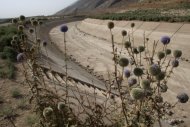Two Harvard professors said Tuesday they were developing a proposal for what would be a first-of-its-kind field experiment to test the risks and effectiveness of a geoengineering technology for intervening in the earth’s climate.
The experiment, which would be conducted from a balloon launched from a NASA facility in New Mexico, would involve putting “micro” amounts of sulfate particles into the air with the goal of learning how they combine with water vapor and affect atmospheric ozone.
The researchers,
James G. Anderson, a professor of atmospheric chemistry, and
David W. Keith, whose field is applied physics, said the amounts involved would be so small that they would have no effect on climate — locally, regionally or globally. “This is an experiment that is completely nonintrusive,” Dr. Anderson said.
(His remarks contradicted
a report in The Guardian that the experiment would involve spraying tens or hundreds of pounds of “sun-reflecting chemical particles into the atmosphere to artificially cool the planet.”)
Geoengineering is a catch-all term for technologies that have been proposed for combating climate change. The technologies fall into two categories: those that would remove some of the heat-trapping carbon dioxide already in the atmosphere, and others that would reduce the amount of sunlight warming the planet.
 Yale University PressResearchers hypothesize that injecting sulfate particles into the atmosphere could mimic the climate-cooling effects of the 1991 eruption of Mount Pinatubo in the Philippines.
Yale University PressResearchers hypothesize that injecting sulfate particles into the atmosphere could mimic the climate-cooling effects of the 1991 eruption of Mount Pinatubo in the Philippines.
The Harvard researchers’ proposal would focus on an often-suggested means of reducing sunlight: injecting sulfate particles into the atmosphere, where they would combine with water vapor to form aerosols that would reflect some of the sun’s rays. The process would mimic what happens naturally from the eruption of large volcanoes like
Mount Pinatubo in the Philippines, which in 1991 spewed millions of tons of sulfur, cooling surface temperatures by about 1 degree Fahrenheit for several years.
But sulfate particles also affect chlorine in the atmosphere, converting it to a form that destroys ozone, a gas that shields the earth from some harmful solar radiation. So before anyone can seriously suggest injecting sulfates into the atmosphere, the effect on ozone must be studied, the researchers said.
Dr. Anderson bristled at the suggestion in The Guardian report that the experiment would use large amounts of the particles. “The whole point of this is to avoid using any quantities of anything that could possibly damage the ozone layer,” he said.
He and Dr. Keith said they expected to have a full proposal written by the end of the year and then would seek public money to pay for it. If they receive funding, the experiment could take place next year, Dr. Anderson said.
Dr. Keith, who is studying other geoengineering technologies including those that would remove carbon dioxide directly from the air, is among several scientists who have received more than $4 million for such research from Bill Gates, a co-founder of Microsoft. But Dr. Keith said he felt strongly that any experiment outside a laboratory that involved injecting even tiny amounts of particles into the atmosphere should involve “public funding and public governance.”
“We will not do an outdoor experiment with that funding,” he said, referring to the money from Mr. Gates.
Geoengineering as an approach to fighting climate change has its share of critics, who argue that the technologies would be costly to develop on a global scale, are generally unproven, and could have disastrous unintended consequences. Even entertaining the idea of geoengineering, some critics say, only serves to distract society from what should be its primary goal: reducing carbon dioxide emissions.
But even some who doubt that geoengineering is a good idea have said that some research in the field should proceed. There has been almost no field research on technologies to reflect sunlight; a British experiment testing the feasibility of pumping liquids to great heights was canceled this year after a dispute over patents.
“I do think that experiments in the outdoors make sense,” Dr. Keith said. “But they need to address clear scientific questions.”





